
The only George V commemorative issue in the 1930s was the Silver Jubilee. The ANZAC and Commerce issues of 1936 were during the short reign of Edward VIII.
Silver Jubilee 1935
Recess printed stamps commemorating the Silver Jubilee of George V were issued on 7 May 1935. They show George V and Queen Mary. The plates were produced by Bradbury Wilkinson who also printed the stamps in London.
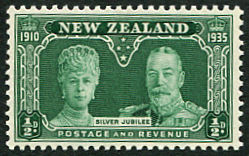
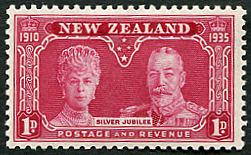
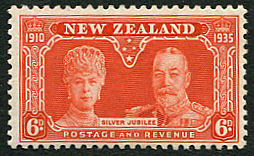
The sheets were in 10 rows of 12. The watermark was NZ and star and the perforation was 11 x 11½. There were two ½d plates numbered 1 and 2, four 1d plates numbered 3, 4, 6 and 7 and one 6d plate numbered 5.
The total numbers issued were:
![]() ½d: 4,800,000
½d: 4,800,000
![]() 1d: 8,400,000
1d: 8,400,000
![]() 6d: 320,000
6d: 320,000
The stamps were withdrawn on 22 June.
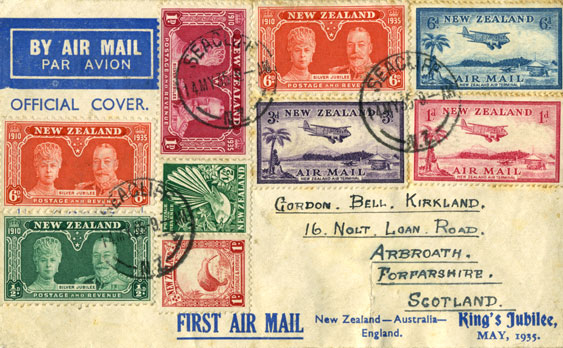
Postmarked May 1935
The first official airmail from New Zealand to Great Britain was planned for 17 May to commemorate the Silver Jubilee. Special covers were produced, but the flight had to be cancelled.
This is one of the covers to the UK prepared for the cancelled flight and contains the complete set of the GV Silver Jubilee stamps. It is postmarked on 14 May and addressed to Scotland. It was sent by sea to Sydney and flown on the Australia - UK airmail service.
It is franked with 2s 1d which was 7d for the (cancelled) trans-Tasman flight and 1s 6d for the Australia - UK air mail.
ANZAC 1936
These stamps commemorated the twentyfirst anniversary of the landing of Australian and New Zealand soldiers at Gallipoli during the First World War in April 1915.
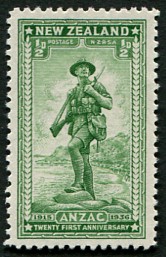
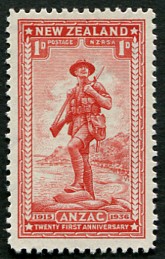
The design was by L.C. Mitchell and the plates were produced and the stamps printed by the Australian Note and Stamp Printer in Melbourne.
The stamps were similar to the Health stamps in that the ½d stamp cost 1d and the 1d stamp 2d with the extra money going to the NZRSA (New Zealand Returned Soldiers' Association).
The paper was Wiggins Teape with the NZ and star watermark and the perforation was 11. The plates had 192 stamps in four panes of 48 while the issued sheets had 48 stamps in 6 rows of 8. The plate number appeared once in the corner of each sheet of 48, with its position differing in each of the four panes.
The stamps were issued on 27 April 1936 and withdrawn from sale on 20 June 1936.
The total numbers sold were:
![]() ½d: 1,840,810
½d: 1,840,810
![]() 1d: 1,179,218
1d: 1,179,218
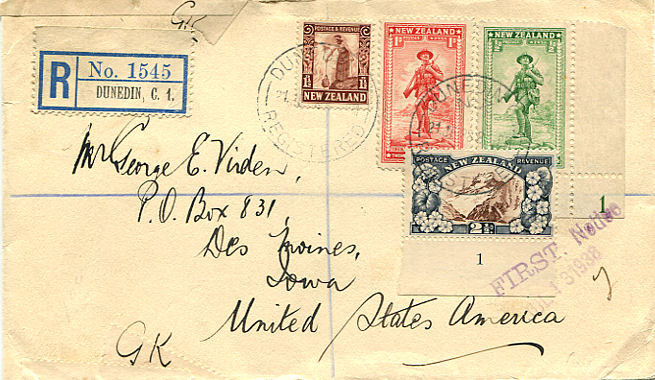
Postmarked June 1938
This registered cover to the USA contains the two ANZAC stamps with the ½d stamp showing a plate number.
It is postmarked on 21 June 1938, has a San Pedro transit on 11 July and a Des Moines receiver on 14 July.
It is franked with 5½d which was 3d registration plus 2½d surface to a foreign country.
Chamber of Commerce 1936
Recess printed stamps commemorating the first meeting in New Zealand of the Chambers of Commerce of the British Empire were issued on 1 October 1936. The plates were produced and the stamps printed by the Australian Note and Stamp Printer in Melbourne.
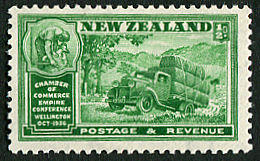
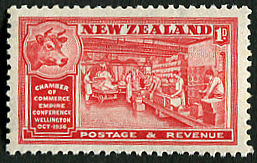
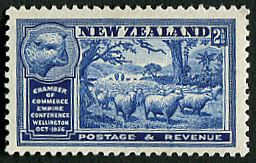
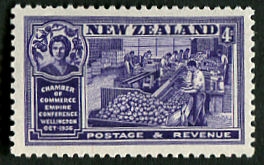
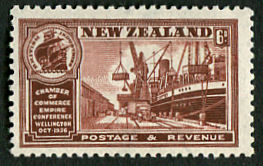
The paper was Wiggins Teape with the NZ and star watermark sideways. The perforation was 11. The plates had 192 stamps in four panes of 48 while the issued sheets had 48 stamps in 6 rows of 8. The plate number appeared once in the corner of each sheet of 48, in the same way as the ANZAC stamps. There were two plates of the 1d.
The total numbers sold were:
![]() ½d: 3,500,000
½d: 3,500,000
![]() 1d: 4,000,000
1d: 4,000,000
![]() 2½d: 357,696
2½d: 357,696
![]() 4d: 354,768
4d: 354,768
![]() 6d: 403,056
6d: 403,056

Postmarked October 1936
This registered cover shows the complete Chamber of Commerce set and is postmarked in Greytown on 3 October 1936.
It is addressed to the Philippines and would have been sent by sea to Sydney before being flown to Singapore. There is a Sydney transit on 12 October and a Singapore transit on 17 October. It would then have gone by sea to Manila and there is a transit mark there on 22 October.
It is franked with 2s 0d which included a 3d registration fee.
The above information is taken from The Postage Stamps of New Zealand Vol 1, published by the Royal Philatelic Society of New Zealand in 1938. All scans were made by the author.